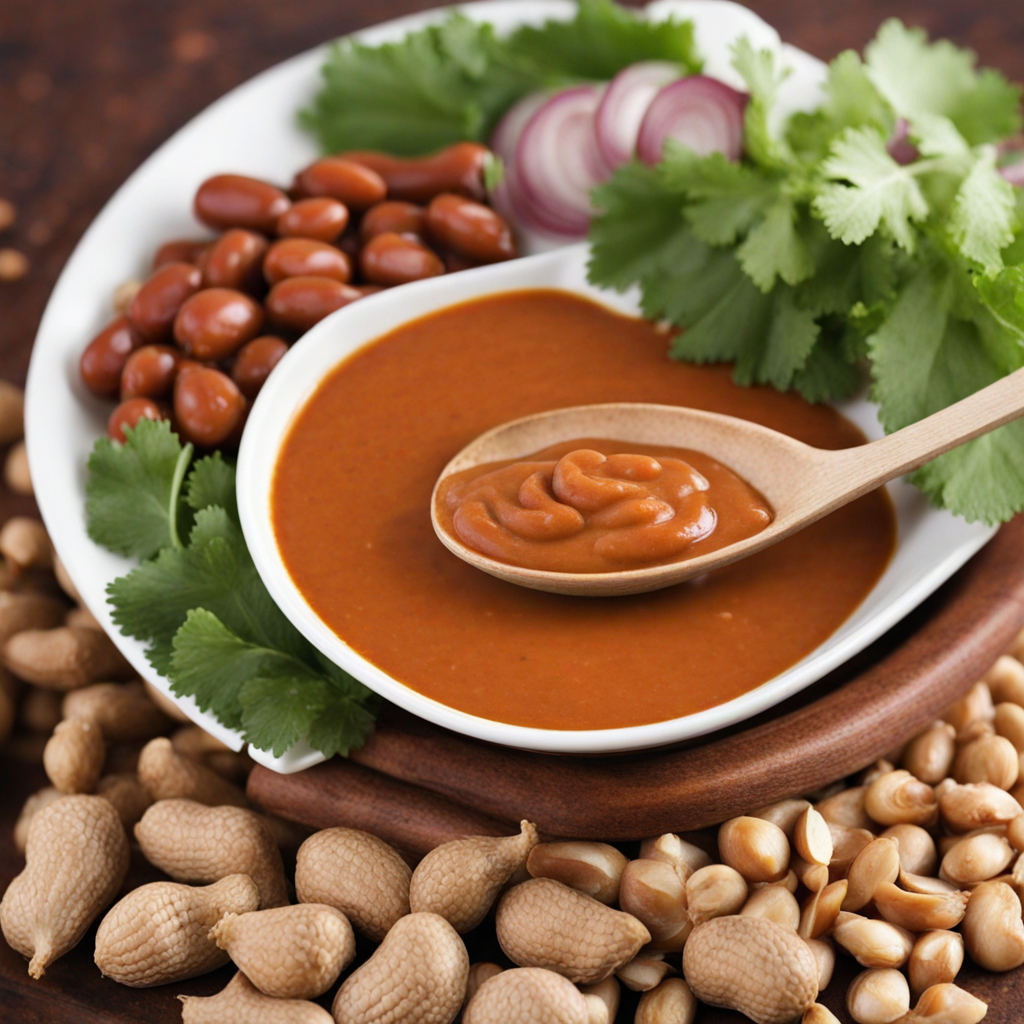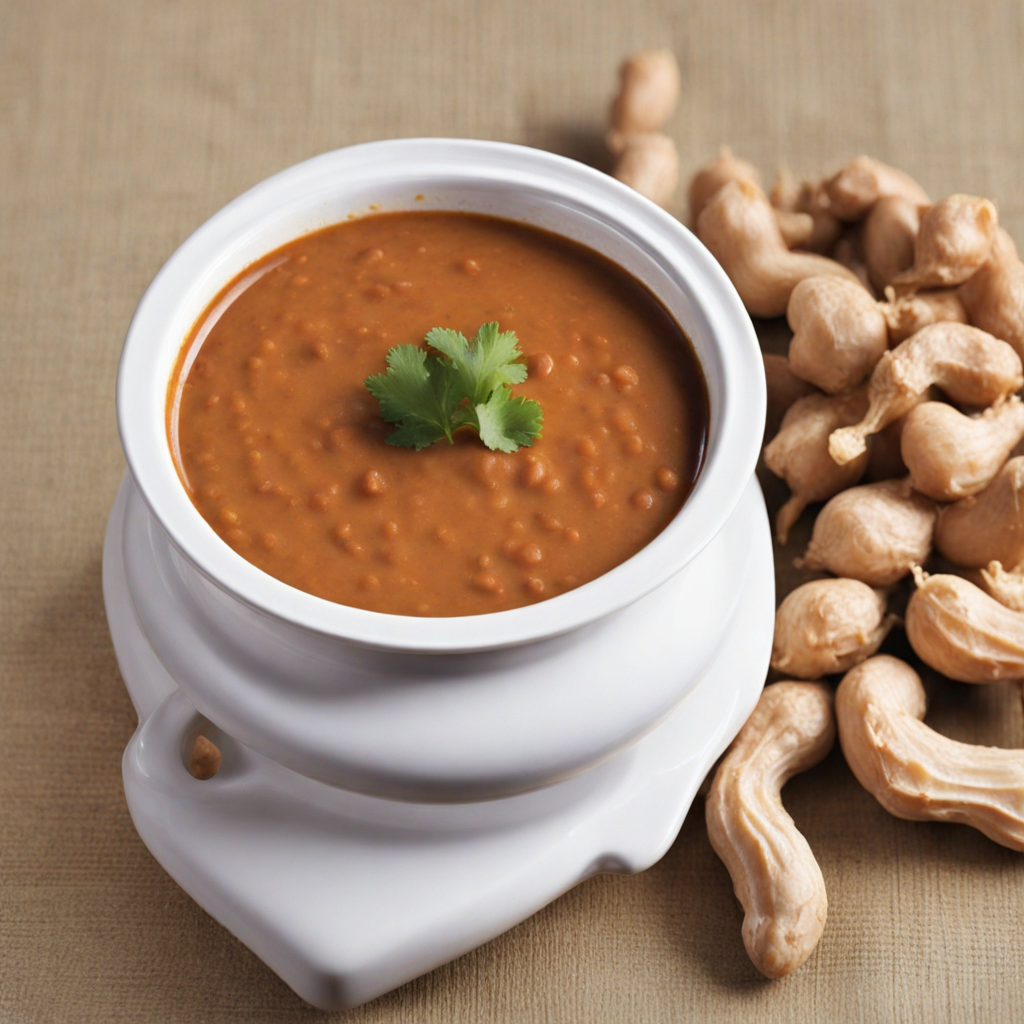Peanut Sauce
Peanut sauce, known locally as "salsa de amendoim," is a beloved staple in Mozambique, showcasing the country's rich culinary heritage. This creamy and flavorful sauce is primarily made from roasted peanuts, which are ground into a smooth paste, and then combined with a variety of spices and ingredients that reflect the vibrant culture of the region. The nutty aroma of the peanuts, paired with the warmth of spices like garlic, ginger, and chili, creates a delightful balance that tantalizes the taste buds and invites exploration. The sauce can be slightly sweet, tangy, and spicy, offering a multi-dimensional flavor experience that is both comforting and exciting. The versatility of peanut sauce in Mozambican cuisine is remarkable, as it is used to enhance a wide array of dishes. It is often served with grilled meats, such as chicken and fish, where it acts as a rich marinade or dipping sauce, adding depth to each bite. Additionally, it is a popular accompaniment to traditional dishes like matapa, a dish made with cassava leaves, or served over rice and vegetables. The creamy texture of the sauce envelops the ingredients, creating a harmonious blend of flavors that is both satisfying and nourishing. For those looking to discover new tastes, peanut sauce from Mozambique offers an unforgettable culinary adventure. With its roots deeply embedded in local traditions, the sauce is not just a condiment but a celebration of the country's agricultural bounty, particularly the abundance of peanuts. Each taste of this delicious sauce transports you to the vibrant markets and kitchens of Mozambique, where the love for food and community comes together in every bowl. Whether enjoyed drizzled over a dish or as a key ingredient in a stew, peanut sauce is a delightful way to experience the richness of Mozambican cuisine.
How It Became This Dish
Molho de Amendoim: A Culinary Journey Through Mozambique Molho de Amendoim, or peanut sauce, is a vibrant and savory condiment that embodies the rich culinary heritage of Mozambique. This dish, with its roots deeply embedded in the nation’s history, is not simply a sauce but a reflection of the diverse cultural influences and agricultural practices that have shaped Mozambique's food landscape. Origins of Molho de Amendoim The origins of Molho de Amendoim can be traced back to the arrival of peanuts in Africa. Originally from South America, peanuts made their way to Africa through the transatlantic trade routes in the 16th century. By the time they reached Mozambique, they were quickly adopted into local diets and agricultural practices. The climate of Mozambique, with its warm temperatures and fertile soil, proved conducive to peanut cultivation, making it a staple crop for many communities. Historically, peanuts have been a significant source of protein in the diets of many Mozambicans, especially in regions where meat was scarce or expensive. As the peanut became a staple, it naturally found its way into various dishes, leading to the development of Molho de Amendoim. This sauce is typically made by grinding roasted peanuts into a paste and then mixing it with a variety of locally available ingredients such as garlic, onions, tomatoes, and spices. The result is a rich, creamy sauce that can be used to enhance the flavor of many traditional Mozambican dishes, particularly those featuring rice or cassava. Cultural Significance Molho de Amendoim is more than just a condiment; it is a cultural symbol that reflects the communal and familial traditions of Mozambique. In many Mozambican households, preparing the sauce is often a communal activity, passed down through generations. The process of making Molho de Amendoim can bring families together, as members collaborate in roasting, grinding, and mixing the ingredients. This communal preparation serves to strengthen family bonds and maintain cultural traditions, ensuring that the knowledge of culinary practices is preserved. In addition to its role in family gatherings, Molho de Amendoim holds a special place in celebrations and feasts. It is often served at weddings, festivals, and other significant events, where it enhances the overall culinary experience. The sauce’s rich flavor complements a variety of dishes, from grilled meats to vegetable stews, making it a beloved accompaniment that enhances the joy of communal eating. Influences and Adaptations The development of Molho de Amendoim has been shaped by a variety of influences over time, reflecting Mozambique’s complex history of trade, colonization, and cultural exchange. The Portuguese colonization of Mozambique, which began in the late 15th century, brought new ingredients and cooking techniques to the region. The integration of European culinary practices with indigenous ingredients led to the evolution of many traditional Mozambican dishes, including Molho de Amendoim. The sauce has also been influenced by the culinary traditions of neighboring countries. For instance, the use of peanuts in cooking can also be found in dishes from other parts of Africa, such as West African groundnut stew. The cross-cultural exchanges that occurred through trade routes, migration, and colonialism facilitated the sharing of recipes and cooking methods, enriching the flavor profile of Molho de Amendoim. As Mozambique has modernized and globalized, so too has Molho de Amendoim. Contemporary chefs and home cooks alike have experimented with the traditional recipe, incorporating new flavors and techniques while still honoring its roots. Ingredients such as coconut milk, chili peppers, and various herbs have found their way into the sauce, creating innovative versions that appeal to a global palate. This evolution demonstrates how traditional foods can adapt and thrive in changing culinary landscapes. The Role of Agriculture The agricultural practices surrounding peanut farming in Mozambique are intrinsic to the identity of Molho de Amendoim. Peanuts are often grown in small farms and gardens, which are vital for local economies and food security. The cultivation of peanuts not only provides a source of nutrition but also generates income for many families. In a country where many people rely on subsistence farming, peanuts play a crucial role in both sustenance and livelihood. Efforts to promote sustainable agricultural practices have also influenced the production of peanuts in Mozambique. Organizations and cooperatives have worked with farmers to improve cultivation techniques, increase yields, and ensure better market access. These initiatives not only support the economy but also help maintain the cultural significance of traditional ingredients like peanuts. The growing awareness of health and nutrition has also led to a resurgence of interest in traditional recipes, including Molho de Amendoim, as people seek healthier, locally sourced options. Modern Day and Global Presence In recent years, the global interest in African cuisine has surged, bringing dishes like Molho de Amendoim to a wider audience. Food festivals, culinary shows, and social media have played a significant role in popularizing traditional Mozambican dishes, with chefs around the world incorporating the sauce into their menus. Molho de Amendoim has found a place in international cuisine, celebrated for its versatility and flavor complexity. As more people discover the unique taste of Molho de Amendoim, its cultural importance is being recognized not just in Mozambique but globally. The sauce serves as a gateway to understanding Mozambican culture, history, and the resilience of its people. It encourages culinary exploration and appreciation for the diverse flavors that African cuisine has to offer. Conclusion Molho de Amendoim is more than just a peanut sauce; it is a testament to the rich history and cultural tapestry of Mozambique. From its origins as a humble ingredient in local diets to its evolution as a beloved condiment, Molho de Amendoim encapsulates the spirit of community, tradition, and adaptation. As Mozambique continues to navigate the complexities of modernity while holding onto its cultural identity, Molho de Amendoim stands as a delicious reminder of the power of food to connect us to our past, our communities, and each other. Whether enjoyed in a bustling market or at a family gathering, this sauce represents the heart and soul of Mozambican cuisine, inviting all to partake in its flavorful legacy.
You may like
Discover local flavors from Mozambique







